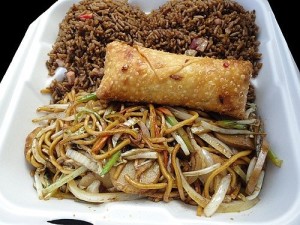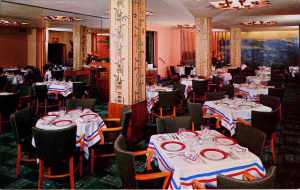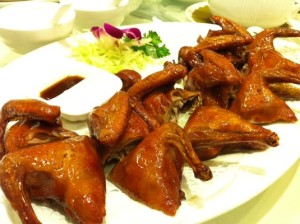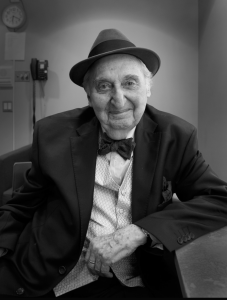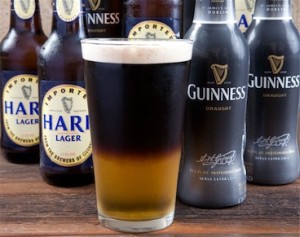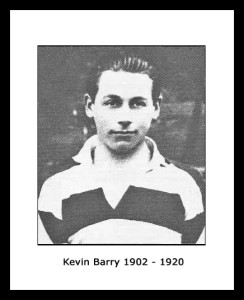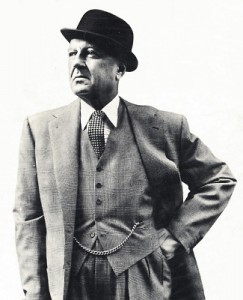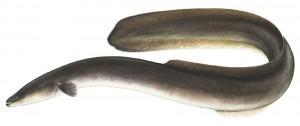Some years ago HG had public relations offices on New York’s W. 57th Street (between Sixth and Seventh Avenues), a territory that remains embedded in HG’s food focused mind as “sandwich heaven.” A quick walk west brought HG to Carnegie Delicatessen for a pastrami sandwich on authentic rye with Russian dressing, sour pickles, French fries and a Dr. Brown’s Cel-Ray beverage. It was a generous plate but nothing like the overstuffed, overpriced parody of a sandwich that Carnegie serves to gullible tourists today. A shorter walk west brought HG to a coffee shop (name not recalled) for a rare roast beef sandwich with raw sliced onion on good pumpernickel bread. Potato salad and an iced coffee completed the fast feast. Sometimes HG ventured east to a deli on Sixth Avenue for smoked Nova Scotia salmon with cream cheese on an onion roll. Hot coffee. When ambitious, HG could venture just a bit further to 58th Street east of Fifth Avenue for the ultimate in sandwich perfection: This was the Reuben sandwich prepared at Reuben’s Restaurant, one of HG’s all time favorite eateries. The sandwich was incomparable. Every element–corned beef, Swiss cheese, sauerkraut, Russian dressing, rye bread–was perfect and the grilling was impeccable. Closer than Reuben’s was Rumpelmayer’s and the Monte Cristo sandwich (described in a recent post). Of course, HG could have ignored sandwiches and simply walked across the street to the Russian Tea Room for borscht and pirozshki; blini with salmon caviar and sour cream or a simple plate of eggplant orientale. Unfortunately, these dishes cried out for an accompaniment of chilled vodka which HG would not been able to resist. So, disciplined HG saved the Russian Tea Room for dinners and weekend lunches. Every two weeks or so, HG’s pal Charles E., an important advertising copywriter, would lunch with HG. (An odd fact: Charles was Jack Kerouac’s teammate on a Columbia football team.) Charles and HG would indulge in a guilty treat: Combo platters (Shrimp chop suey, egg roll, pork fried rice) served with lots of duck sauce and chinese mustard at a dingy Chinese restaurant on Sixth just north of 58th. Preceded by egg drop soup, finished with an almond cookie. Like an illicit couple, HG and Charles would leave with furtive glances, hoping that no one would note how they had breached culinary values.
Sandwich Heaven with A Guilty Pleasure
October 28th, 2014 § 0 comments § permalink
Rumpelmayer’s
October 23rd, 2014 § 9 comments § permalink
Ah, Rumpelmayer’s!! That’s a name that will provoke a sigh from many older (and not so old) New Yorkers. This was a long closed restaurant/tea room/ice cream parlor in The St. Moritz Hotel (now the Ritz-Carlton) on the corner of Sixth Avenue and Central Park South. The original Rumpelmayer’s was in Vienna (with branches in London and Paris) and the New York version retained a European air (it was a favorite of Marlene Dietrich and many other European expatriates). Its design was vaguely art deco softened by heaps of colorful stuffed animals that adorned the walls and corner tables. The animals were very much liked by young customers (and were sometimes purchased for them by doting parents). A restaurant reviewer of the 1930’s called Rumpelmayer’s “the haunt of New York’s most pampered children.” Well, HG/BSK’s offspring were not pampered but they sure loved Rumpelmayer’s. As part of special occasion outings (known as “treat days”), the youngsters were seated at Rumpelmayer’s marble counter for opulent hot fudge sundaes. The ice cream was super rich. The hot fudge was really thick and warm –the sweetness being off-set by the slight bitterness of the high quality chocolate (Says SJ – Post-Rumpelmayer’s I was always disappointed by chocolate sundaes as the “hot fudge” tasted like chocolate syrup, but recently I had a Sundae at Brooklyn’s Chocolate Room and their hot fudge was of the same quality and the flavor brought me right back to Rumpelemayer’s counter). The ultimate treat. When HG had offices nearby, HG would often visit Rumpelemayer’s for a late breakfast or early lunch. HG’s food choice was a delicacy that has long disappeared from menus: The Monte Cristo Sandwich. This was a sandwich of French toast enclosing sliced ham and melted Gruyere (or Emmenthaler) cheese. Served with a pitcher of warmed maple syrup. HG would eat this lush dish, sip coffee and watch snowflakes descend upon Central Park. Nostalgia, anyone??
Tasty Little Birds
October 22nd, 2014 § 0 comments § permalink
Years ago,squab, a dish HG much enjoyed, was found on the menus of many good New York restaurants. Rarely found anymore (except in New York’s various Chinatowns in Manhattan, Brooklyn and Queens). A squab is a very young pigeon, four weeks old or less. It is a lush little bird with meat that tastes like the very best dark meat of a chicken or turkey. HG recalls eating squab prepared in many delectable ways, usually roasted: stuffed with wild rice; roasted with fresh figs; wrapped in bacon and accompanied with juicy roast grapes. As noted, squab can be found in butcher shops in Chinese neighborhoods and on Chinese restaurant menus. The squab is usually butterflied and fried. The glazed skin turns very brown and its crackling texture goes nicely with the rich flesh. Forget Chinese tea. The best accompaniment is a good red Bordeaux or Cabernet Sauvignon. The best Chinese prepared squab in North America can be found at the excellent Sun Sui Wah restaurant in the Mt. Pleasant neighborhood of Vancouver, B.C.. HG’s dining companions at the restaurant were often disconcerted when HG bit off the little bird’s head and crunched the tasty little morsel. HG has no sentimentality when it comes to dining.
The Jewish Waiter R.I.P.
September 25th, 2014 § 2 comments § permalink
The old time New York Jewish waiter has disappeared. Nostalgia, of course, colors many memories of these flat-footed, bad tempered guys. They were not subservient. They did not introduce themselves: “My Name is Moisha. I’ll be your waitperson tonight.” They were not actors, directors, artists. They were career waiters and not happy about it. Most Jewish waiters disapproved of HG. At Gitlitz, located on Broadway and 79th, the best of all delicatessens, HG always ordered a sandwich that HG’s waiter considered an abomination: Pastrami and chopped liver on rye with Russian dressing. “You sure you want Russian dressing?” “Yes.” “Feh!!”, exclaimed the waiter. At the Paramount Dairy on W. 72nd Street HG would order warm gefilte fish in broth and wave away the proffered challah (egg bread). HG would accompany the fish with buttered onion rolls, undisturbed by critical glances. The Jewish waiter attitude was exemplified by a response HG received at Moscowitz and Lupowitz on the Lower East Side. “So, what’s good tonight?”. queried HG. “Whatever we got is too good for you.” The wonderful actor Fyvush Finkel, a stalwart of the Yiddish stage, was a long time customer at Cafe Royal on Second Avenue, the hangout of Yiddish actors, musicians, composers, directors, producers, press agents, playwrights, set designers and others connected with New York’s once vibrant Yiddish theater. Finkel always sat at one waiter’s table. He would watch some beautiful pot roast go by and order it. The waiter would shake his head. “Nem (take) deh chicken.” So, Finkel ate chicken. Went on for years. “Nem deh chicken.” Then Cafe Royal closed before he could taste the pot roast. Asked why he always sat at the waiter’s table, Finkel explained: “I am a masochist.”
Black and Tan
September 24th, 2014 § 0 comments § permalink
An oddity. One of HG’s favorite drinks and favorite sweet confections are named for a brutal, hated military (or police) force. The Black and Tans (the brainchild of Winston Churchill, unfortunately) were a force of World War One veterans recruited to aid the Royal Irish Constabulary to fight the Irish Republican Army during the Irish War for Independence (1919-1922). They had a reputation for fierce brutality, much of it directed against the civilian population. Their name came from their khaki uniforms and black headgear. Some 9,000 served in Ireland and more than a third died or left the service. During their underground terrorist war against the British military in pre-Israel Palestine, the Irgun (and other Jewish militants including young HG, an Irgun sympathizer) often referred to British soldiers in Palestine as “Black and Tans.” Given all of that, it does seem a bit strange that HG often ordered a “Black and Tan” (one half Guinness Stout and one half Bass Ale, the perfect accompaniment to oysters). Howard W., HG’s journalistic mentor and an I.R.A. veteran, would often sup with HG on oysters at the Grand Central Oyster Bar. Howard would never say “Black and Tan” (he had killed a number of them) but simply order a bottle of Guinness and a bottle of Bass. As for sweets: In the Bronx youth of HG, the young man’s favorite ice cream parlor was Addie Vallin’s (Gerard Avenue and W. 161st Street). The “Black and Tan” was an ice cream soda. Coffee ice cream, milk, seltzer and a slightly bitter chocolate sauce mixed with chopped pecans. An incomparable ice cream soda.
Saloon Songs
September 18th, 2014 § 0 comments § permalink
The time: Early 1950’s. The place: Murphy’s Bar & Grill on 45th Street and Third Avenue (the El roaring overhead). The occasion: A drunken informal observation of HG’s birthday. While HG ate pickled pork knuckles with mustard accompanied by boilermakers (rye whiskey with beer chasers), Dan M., a Daily Mirror rewrite man, sang HG’s birthday present: A full length, heart ending version of “Kevin Barry”. The many verse song told of the martyrdom at the hands of the British of 18-year-old Kevin Barry, medical student and soldier in the Irish Republican Army. Barry met his fate during the Irish War For Independence. He was hung on Nov.1, 1920. The song noted: “A lad of 18 summers, Kevin Barry gave his young life for Ireland and the cause of liberty.” Memorable was Barry’s request of the British: “Shoot me like an Irish soldier. Don’t hang me like a dog.” The British hung him. Dan M., who had a varied repertoire, followed “Kevin Barry” with a rousing rendition of the Yiddish music hall hit, “Romania, Romania” as done in the style of Aaron Lebedeff. Present at the raucous festivities was Howard W., HG’s journalism and life mentor. An I.R.A. gunman during the War For Independence and the subsequent Civil War, Howard W. did not join in the “Kevin Barry” song. He hated all Irish rebel songs and, disillusioned with violence, called his experiences “a catastrophe of blood, treachery and politics.” He despised the Irish-American habitués of Third Avenue bars and their loud Irish patriotism. ‘Whiskey warriors,” said Howard. He figured in an extraordinary incident where, as he boarded the Third Avenue trolley (they used to run under the El), the driver suddenly leaped out of his driver’s seat, abandoned his vehicle and ran away. It seemed that the driver, who had been an informer for the British, recognized Howard as an I.R.A, enforcer. He thought his final moment had come. Howard made no comment about the incident. There was much saloon singing during HG’s journalistic days. Nat O.,a newspaper motorcycle messenger (and a former driver for burglars), was an HG drinking companion. Nat, who was Jewish, had a remarkable Irish tenor voice and a vast array of sentimental Irish sings of the “Mother Machree,” and “Danny Boy” vintage. Whenever Nat raised his voice, he and HG rarely paid for a drink. Unfortunately, after many songs and drinks, Nat would become hostile and evenings ended with fisticuffs. Somehow HG emerged always without injury. HG’s favorite saloon singer was a quasi girlfriend, Alice C. Only in her twenties when HG knew her, Alice (mature for her age), ran away from home at the age of 14 and became a Las Vegas showgirl. This was followed by a career as a singer in Jewish Borscht Belt hotels where she learned a number of schmaltzy, tear jerking melodies. Her next career was as a heavy drinking Broadway press agent (that’s when she and HG became pals). HG, Alice, police reporters, bail bondsmen, loan sharks and Jewish thugs had a late night hangout: Dubiner’s Bar and Restaurant on Stanton Street off Allen on the Lower East Side. The specialties of the house were gefilte fish with hair-raising horseradish, chopped liver with abundant chicken fat and garlicky, room temperature fried fish. HG enjoyed these goodies with lots of vodka. Alice, a determined bourbon drinker, would sing. “Yiddishe Mama” and “Papirosen” were two of her big numbers. She could really milk those songs. HG does not exaggerate: Tears rolled down the cheeks of the tough guys. What happened to Alice? She abandoned her dissolute ways (HG played a small part in that development). Went to medical school. Became a pediatrician. Lived a productive and conventional life in the suburbs with two children and an investment banker husband. Go figure.
Department Store Dining
August 6th, 2014 § 0 comments § permalink
There’s been a long tradition of New York department stores containing some fairly beloved restaurants. The intent, obviously, is to keep the customer in the store and keep her shopping (the gender specific “her” is probably an out-dated notion, but NY’s department stores were initially created for and catered to an almost exclusively female audience). Tea sandwiches, salads and exuberant desserts were featured. Gourmands sneered at these dainties but during HG’s days in New York, HG often lunched in department stores. HG’s favorite was Lord & Taylor. The store broke with tradition by operating a soup bar. A very large African-American man wearing a chef’s toque ladled soups from a big kettle. The soup was served with Ritz crackers and was a cold weather treat. Dignified B. Altman (long gone) on 34th and Fifth was famed for ladies’ intimate apparel and high quality furniture. The restaurant was classy. The hands down favorite of fashionable women was Bergdorf Goodman with restaurants in the basement and on a high floor (spectacular Central Park views). Alex Witchel of The New York Times did a charming story (in 2013) about lunching there with writer Patricia Volk. Paris, of course, has the best department store restaurants. Bon Marche’s are the height of chic but for variety nothing tops Galeries Lafayette. There’s a dim sum restaurant, an oyster and fish eatery, Italian restaurant, Spanish counter with the best Serrano ham. There’s pizza, tapas, paella, Indian tandoori..and more.. (HG’s pal, journalist/wine expert/author Peter Hellman did a nice article on Paris department store dining for The New York Times some years ago). In addition to dining, Bon Marche and Galeries Lafayette have stupendous food and wine departments. Bon Marche’s, the Epicerie, is epic. HG/BSK have many happy memories of smoked salmon, country pate, jambon persille, countless varieties of perfectly ripened cheese and savory charcuterie. The makings of exuberant dinners with wine and fresh baguettes in HG/BSK’s rented Paris apartments. Of course, the glories of Paris department store dining and food halls (including the splendid one at London’s Harrod’s) dwindle when compared to the limitless cornucopia of delicacies offered at KaDeWe, the Berlin department store (largest in Europe). There are two vast floors of food plus a rooftop cafeteria. HG/BSK plan to be there sometime in the future and indulge in oysters and champagne plus many other good things from every part of the world.
Fresh and Simple Lunch at Cookshop
July 8th, 2014 § 0 comments § permalink
Was it Lucius Beebe (or Oscar Wilde) who said (and HG paraphrases): “My tastes are simple. I like only the very best.” ? HG agrees (in part). HG deplores over elaborate, over sauced, fussed over food. Through the years HG dined at many temples of high cuisine (Le Pavillon, Lutece, La Cote Basque, Le Bernardin in New York; Connaught Restaurant and Savoy Grill in London; the once glorious Laperouse in Paris). Even in these vaunted places, HG ordered simple dishes (mixed grill at the Connaught; grilled sole at the Savoy and roast duck with turnips at Pavillon). HG may be accused of favoritism and family pride, but HG’s ideal of dining is Cookshop, the restaurant run by HG’s daughter, Victoria Freeman,and her husband, chef Marc Meyer. It is located on Tenth Avenue in New York’s Chelsea neighborhood and is always filled with a lively, good looking crowd. The restaurant has been in the forefront of the farm-to-table, locavore movement. Meyer treats his superior ingredients with restraint and imagination. A tip from HG. Settle down with a glass of chilled rose (from Slovenia, surprisingly). Have some radishes with herbed butter and sea salt. Follow with roasted asparagus (sauce gribiche). Then, share a Hudson Valley Chicken Breast Salad. This is not the usual mayonnaise-drenched mess. The menu describes it this way: “Chicken, arugula, cucumbers, sliced carrots, radish, spiced walnut, golden raisin, sherry vinaigrette.” Crunchy with summery flavors and hints of salt and sweetness. HG shrugs off charges of nepotism. Can one imagine a better summer lunch? (An afterthought: Alexander Lobrano, the Paris-based food writer for the New York Times and many other publications and the author of the best guide to Paris dining, Hungry For Paris, dined at Cookshop while visiting New York. He expressed a wish that Paris should have more restaurants like Cookshop).
Unfairly Unpopular Eels
July 2nd, 2014 § 0 comments § permalink
HG has had an interest in eels ever since HG learned that Freud, an HG hero, spent a youthful year researching the snake-like sea creature. The appearance of eels tend to turn off a great number of folks; but, they are nutritious, delicious and in Japan, where unagi is a favorite food, they are lauded as being an aid to vitality and longevity (the maternal grandfather of Exquiiste Maiko — HG’s Japanese daughter-in-law and favorite home chef — lived to be 100 and ate eel almost every day). HG enjoys unagi sushi at Shohko Cafe, the very good Japanese restaurant in Santa Fe. HG used to obtain unagi at Whole Foods and enjoy it as part of a sashimi platter. HG also liked to top a bowl of rice with much sliced unagi. Alas, Whole Foods no longer carries unagi and HG can’t find a good online source. However, the best eel dish HG ever experienced was at yesteryear’s great French restaurant, Henri Soule’s Le Pavillon. Soule served lightly smoked filets of eel with whipped cream spiked with lots of freshly grated, strong horse radish. Divine. Eel remains popular with London’s working class who enjoy jellied eels and patronize some of the city’s few remaining eel-and-pie restaurants. HG fears that this eel dish may be a specialized English taste like mushy peas, Marmite and the chip butty.
Spud Heaven
March 31st, 2014 § 0 comments § permalink
The best potato dish ever devised by humankind is pommes souflee. These airy, crisp bits of spud heaven are a testament to culinary creativity. The method of preparation is a double frying of potatoes and requires efficient temperature control and deft hands. As mentioned in a previous post, HG always enjoyed them at the old Oak Room in New York’s Plaza Hotel. In London, HG consumed them accompanying a toothsome mixed grill in the restaurant of the Connaught Hotel ( In its heyday, despite its English location, it was hailed as the best French restaurant in the world). However, the best pommes souflee were found at the long closed, aptly named Charles a la Pommes Souflee on New York’s E. 55th Street. Second helpings were encouraged. HG took advantage. Sadly, pommes souflee have virtually disappeared from New York, Paris and London menus. There is one place to taste them in all their glory. This means a voyage to Paris and a visit to Au Boeuf Couronne, a venerable steak house in Paris 19e. Order a saignant (rare) steak topped with either sauce bearnaise or beef marrow. A big side of the lush taters. Clog your arteries with pleasure.
